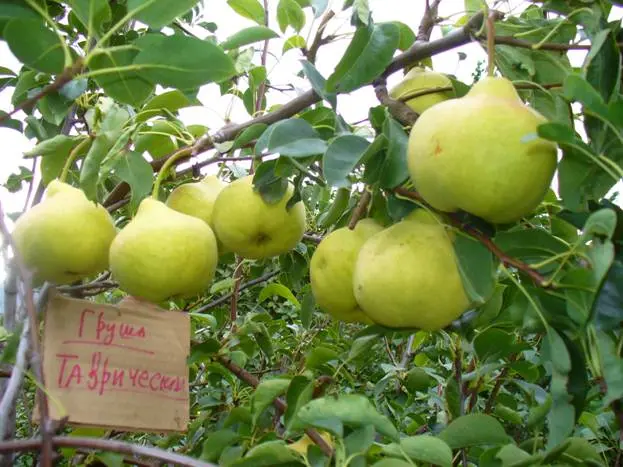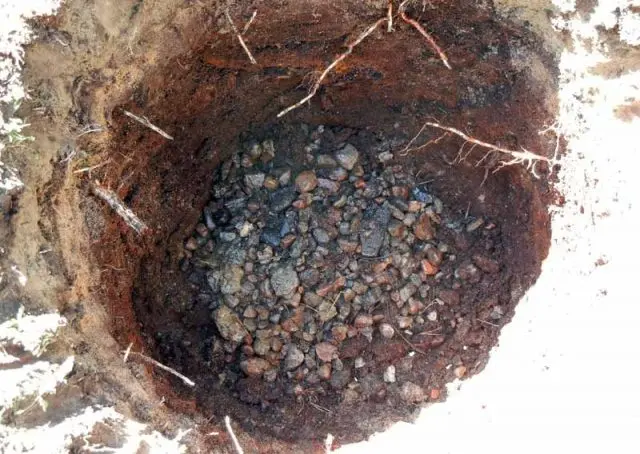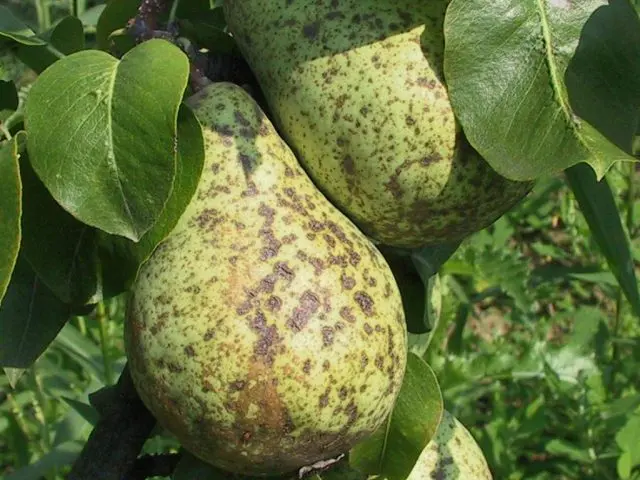Contents
- Description of the pear variety Tauride
- Characteristics of pear fruit
- Pros and cons of the Tauride variety
- Similarities between pear varieties Dikanka and Tavricheskaya
- Optimal growing conditions
- Planting and caring for Tauride pear
- Pollination
- Productivity
- Diseases and pests
- Reviews about Tauride pear
- Conclusion
Description, photos and reviews of the Tauride pear indicate that this is one of the tasty large-fruited varieties that can be grown not only for yourself, but also for sale. In general, the tree is unpretentious, but it needs mandatory care.
Description of the pear variety Tauride
Pear Tavricheskaya is a middle-aged variety, bred in 1934 by crossing Bere Bosk and Dikanka winter. Refers to late, autumn varieties. A tree with good frost resistance and drought resistance, painlessly tolerates temperatures as low as -30°C. The flowering of the variety occurs in May.
A tree of medium vigor, with normal care reaches 3 m. The crown is compact, well leafy, pyramidal.
Characteristics of pear fruit
The description of the variety indicates that the fruits are large, more than 200 g. Judging by the reviews, it is possible to grow the fruit of a Tauride pear up to 500 g. The photo shows that this is quite real, but it will take effort and diligent care of the tree.

The shape of the fruit is ovoid, the surface is bumpy. The skin is moderately dense, saturated yellow, with a characteristic pink barrel. The pulp is creamy, granular, juicy. The taste of the fruit is sweet and sour.
Variety Tavricheskaya is suitable for all types of processing and fresh consumption. It makes delicious compotes, jams, dried fruits.
Harvest ripening occurs at the end of September. The keeping quality of the variety is good. At a temperature of +2°C, pears are preserved until mid-January. After harvesting, the fruits can be ripened at home, they quickly gain flavor and oiliness.
Pros and cons of the Tauride variety
The Tauride variety has several advantages:
- large fruits;
- excellent taste;
- versatility of application;
- precociousness;
- high yield;
- frost resistance;
- drought resistance.
There are practically no drawbacks to the pear. The only negative is that the fruits become smaller due to the abundant harvest. Normalization of ovaries is required. Although some gardeners do not consider this a significant drawback. In addition, the variety is demanding on top dressing. Without proper care, growing large fruits will not work.
Similarities between pear varieties Dikanka and Tavricheskaya
If we compare the Tauride variety with the Dikanka pear, we can see some similarities:
- Trees of medium vigor, well leafy.
- Variety Dikanka with good winter hardiness, the same is noted in the description of the Tauride pear.
- The fruits of Dikanka are large, even slightly larger than those of the Tauride. With good care, they reach 700 g.
- Both trees bear abundant fruit, but pears become smaller in the harvest year.
- Varieties Dikanka and Tavricheskaya are late summer varieties. Ripen in late September or early October.
- Trees are demanding on soil and growing conditions.
- The fruits of both varieties are well stored and transported.
Based on these characteristics, we can conclude that the Dikanka variety transferred only its best qualities to the Tauride pear.
Optimal growing conditions
Before planting the Tauride variety, you need to choose a suitable place for the tree. The pear does not tolerate transplantation, so they immediately prepare a permanent site where the plant will feel good in winter and summer.
The lightest area is allocated for landing, well protected from cold winds and drafts. The Tauride pear does not tolerate close proximity to groundwater, so it is planted on an elevated place.

Apple trees will be good neighbors for pears. But next to the mountain ash, it will not grow. Trees have the same diseases and pests that quickly move from one plant to another.
For planting, nutrient soil is preferable; on acidic or waterlogged soil, the tree will quickly die. A place for a pear is dug up in advance, the necessary fertilizers are applied and a hole is prepared.
Planting and caring for Tauride pear
In order for the seedlings to take root well and quickly, trees no older than 2 years are chosen for planting. Particular attention should be paid to their condition. On the trunks there should be no damage and dry areas, exfoliation of the bark, growths. The root system is well developed, has several branches and many small roots.
It is better to plant a Tauride pear in early spring or late autumn, when there is no sap flow. Work must be completed 2 weeks before the first frost, otherwise the seedling will not have time to take root.
Rules of landing
The pit is prepared in advance, its size depends on the root system, but not less than 70 cm wide and 80 cm deep. The bottom is well drained, covered with nutrient soil and a pear support is established.
The soil for planting is mixed with mineral fertilizers:
- mature compost;
- potassium salt;
- superphosphate.
The mixture is poured into the pit, mixed well and left to settle the earth. Then proceed to planting pears:
- In the pit, a mound is formed from fertile soil, a seedling is installed and the roots are straightened.
- The voids are covered with earth, well rammed. The root neck is left on the surface.
- The seedling is watered, tied to a support.
After planting a pear, the near-trunk circle is mulched with straw, humus or rotted manure.
Watering and top dressing
At first, the Tauride pear seedling needs abundant watering. It is important to ensure that the soil under the tree does not dry out. Once a week, the tree is watered, spending up to 10 liters per plant. If there is a lot of precipitation, then it is not necessary to additionally moisten the soil. It is enough to loosen so that the roots do not begin to rot.
In the future, the Tauride pear is watered as needed. During dry periods more often than usual. At least 4 waterings should be done per season, and the last watering is water-charging at the end of autumn.
It is necessary to feed the pear, otherwise the fruits will shrink. There is no need to apply fertilizer immediately after planting and in 1 growing year. If the pit is filled according to all the rules, then the seedling will have enough food. The next spring, start feeding. For 1 plant mix:
- 150 g of urea;
- 1 st. l. saltpeter;
- 5 L of water.
Chicken manure or urea is added to the finished fertilizer. Once a year, potash fertilizers are applied. At the end of May, the pear is watered with a solution of nitroammophoska.
Trimming
For fruit trees, pruning is recommended to be done 2 times a season. In the spring, sanitary cleaning is carried out: dry, damaged shoots are removed. Make a shaping cut. In autumn, fattening and thickening branches are cut out.
Immediately after planting, the seedlings are shortened by a third. And the next year they start pruning.
Whitewash
In early spring and autumn, experienced gardeners recommend whitewashing the trunk and skeletal branches of the Tauride pear. This procedure helps protect the tree from pests and diseases. For whitewashing use slaked lime and copper sulfate. The seedling must first be prepared:
- Cut off the exfoliated bark and growths.
- Clean the trunk to healthy tissue.
- Treat the affected areas and cracks with garden pitch so that pests do not penetrate into the trunk.
Whitewash is applied in several layers. Particular attention is paid to the affected areas and cracks.
Preparation for winter
In regions with a mild climate, the tree hibernates without additional shelter. In the Northern regions, the Tauride pear must be insulated. To do this, the trunk is wrapped with burlap or agrofiber. The trunk circle is mulched with dry leaves or humus. A layer of mulch is at least 15-20 cm. In winter, snow is additionally thrown.
Pollination
The Tauride pear is a self-fertile variety, it does not need additional pollination. However, it has been noticed that a record harvest can be harvested if other varieties are grown nearby:
- Dessert;
- Crimean Fragrant;
- Vassa;
- Maria;
- emerald;
- Yakimovskaya;
- The highlight of the Crimea.
This neighborhood increases the amount of ovary up to 50%.
Productivity
Variety Tavricheskaya – early-growing. Fruiting begins with 3-4 years of cultivation. Life expectancy is about 15-20 years. Throughout this period, the pear bears fruit regularly. Yield increases gradually. From 1 adult plant, it is possible to collect up to 120 kg of pears.
Diseases and pests
A pear of this variety has good immunity, but from improper care it can get sick and suffer from pests. The most common growing problems are:
- scab;
- stem rot;
- powdery mildew;
- a bug
- itching;
- gallica;
- pear fruit cake;
- copperplate.
Pests and diseases take up to 50% of the crop. In some cases, losses can be almost 100%. To protect the tree, you need to regularly inspect the shoots and leaves, carry out preventive spraying with complex preparations.

Reviews about Tauride pear
Conclusion
Description, photos and reviews about the Tauride pear help most gardeners choose the right variety for their site. Caring for a tree is not so difficult, so it can be recommended even to those who rarely visit the country. In addition, 1 seedling is enough for a good harvest, which pleases the owners of small gardens.









